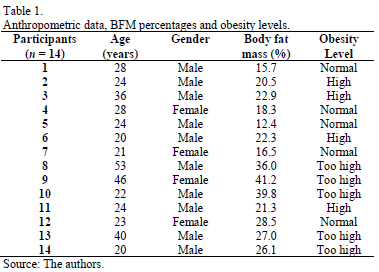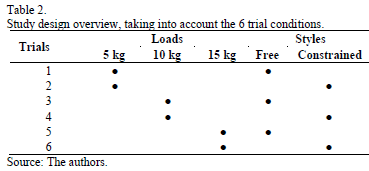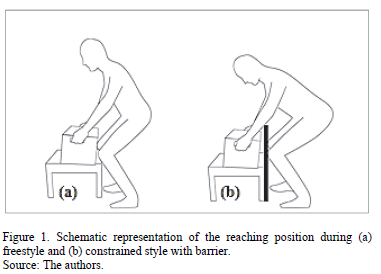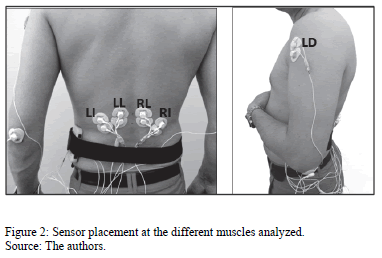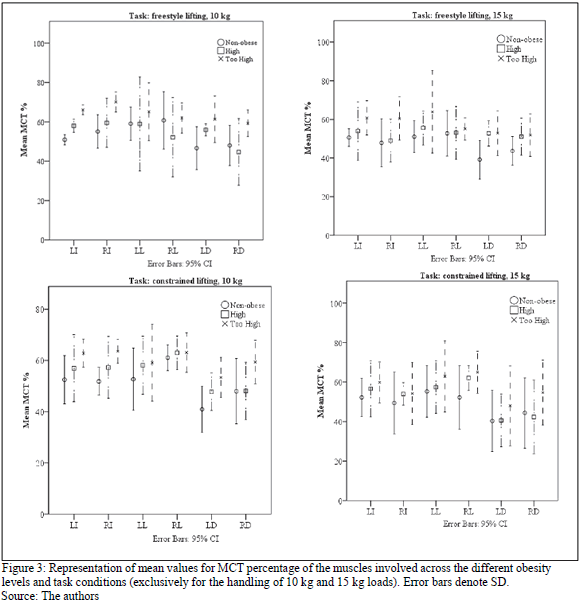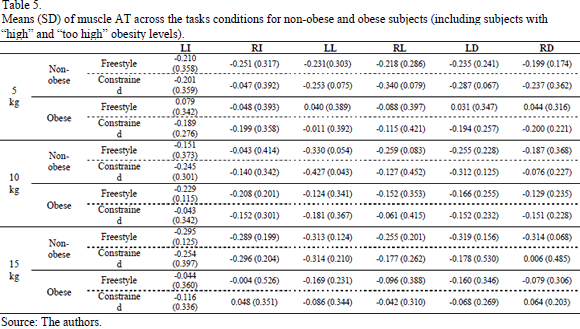Services on Demand
Journal
Article
Indicators
-
 Cited by SciELO
Cited by SciELO -
 Access statistics
Access statistics
Related links
-
 Cited by Google
Cited by Google -
 Similars in
SciELO
Similars in
SciELO -
 Similars in Google
Similars in Google
Share
DYNA
Print version ISSN 0012-7353
Dyna rev.fac.nac.minas vol.83 no.196 Medellín Mar./Apr. 2016
https://doi.org/10.15446/dyna.v83n196.56609
DOI: http://dx.doi.org/10.15446/dyna.v83n196.56609
Differences in muscular activity between obese and non-obese workers during manual lifting
Diferencias en la actividad muscular entre trabajadores obesos y no obesos durante la elevación manual de cargas
Ana Colim a, Pedro Arezes b, Paulo Flores c & Ana Cristina Braga d
a Production and Systems Department, University of Minho, Guimarães, Portugal. ana.colim@dps.uminho.pt
b Production and Systems Department, University of Minho, Guimarães, Portugal. parezes@dps.uminho.pt
c Mechanical Engineering Department, University of Minho, Guimarães, Portugal. pflores@dem.uminho.pt
d Production and Systems Department, University of Minho, Guimarães, Portugal. acb@dps.uminho.pt
Received: December 01rd, 2015. Received in revised form: February 02nd, 2016. Accepted: March 09th, 2016.
This work is licensed under a Creative Commons Attribution-NonCommercial-NoDerivatives 4.0 International License.

Abstract
The prevalence of obesity is increasing throughout the workforce. Manual lifting tasks are common and can produce significant muscle loading. This study compared muscular activity between obese and non-obese subjects, using surface Electromyography (EMG), during manual lifting. Six different lifting tasks (with 5, 10 and 15 kg loads in free and constrained styles) were performed by 14 participants with different obesity levels. EMG data normalization was based on the percentage of Maximum Contraction during each Task (MCT). Muscle Activation Times (AT) before each task were also evaluated. The study suggests that obesity can increase MCT and delay muscle AT. These findings reinforce the need to develop further studies focused on obesity as a risk factor for the development of musculoskeletal disorders.
Keywords: obesity; manual lifting; surface electromyography; maximum contraction during task; muscle activation time.
Resumen
La prevalencia de la obesidad está aumentando también entre los trabajadores. Las tareas de elevación manual son comunes y pueden producir una significativa carga muscular. El actual estudio comparó la actividad muscular entre sujetos obesos y no obesos, mediante la aplicación de electromiografía de superficie (EMG) durante la elevación manual de cargas. Seis tareas de elevación muy diversas (con cargas de 5, 10 y 15 kg y con estilos de elevación libre y restringido) fueran solicitadas a los 14 sujetos con diferentes niveles de obesidad. La normalización de los datos de EMG fue basada en el porcentaje de la contracción máxima (MCT) durante cada tarea. También se ha evaluado el tiempo de la activación (AT) del músculo antes de cada tarea. El estudio sugiere que la obesidad puede aumentar el MCT y retrasar el AT del músculo. Estos resultados refuerzan la necesidad de desarrollar nuevos estudios, los cuales se deben centrar en la obesidad como un factor de riesgo para la aparición de síntomas y trastornos musculoesqueléticos.
Palabras-clave: obesidad; elevación manual; electromiografía de superficie; contracción máxima durante la tarea; tiempo de activación muscular.
1. Introduction
1.1. Effects of obesity on work performance
Improved social conditions among the population have led to an increase in the incidence of obesity in several countries, principally in the industrialized world. Global statistics confirm that obesity has more than doubled since 1980 and that, currently, more than 1.4 billion adults are overweight [1]. Obese subjects therefore represent a growing fraction of the workforce [2].
Obesity can be associated with psychological, social and physical problems, including Work-related Musculoskeletal Disorders (WRMSDs), which can negatively affect productivity [3,4]. Additionally, overweight subjects are absent from work due to illness more frequently and for longer periods than the non-obese [5]. This absenteeism is frequently related to WRMSDs [6].
Specific studies have analyzed different activities of daily life, comparing obese with non-obese subjects. Biomechanical studies of human walking have demonstrated that body fat mass (BFM) affects this activity [7]. For example, obese subjects reveal higher ground reaction forces [8], altered knee joint kinematics [9] and higher metabolic rates, even though the explanation for this last aspect has not been clearly established [10].
Additionally, stressful working postures are known to be related to the risk of WRMSDs. These postures can be affected by excessive BFM. However, the effects of obesity on posture maintenance during occupational tasks are rarely investigated [11]. Postural analysis tools, frequently used in workplace ergonomic interventions, seem to consider only people with normal weight. Based on this assumption, Park et al. [12] carried out psychophysical research with obese and non-obese subjects who were asked to perform static box-holding tasks in different working postures. In this study, the obese group reported higher perceived overload in all the postures considered, demonstrating that obesity increases postural stress. The findings of another study [13], also showed that the trunk posture of obese subjects was more flexed and that they experienced increased hip joint moment and greater hip-to-bench distance during a simulated standing work task.
Furthermore, it has also been demonstrated that obese subjects have more problems with work-restricting musculoskeletal pain than subjects of normal weight [14]. From the biomechanical point of view, excessive body mass can negatively affect the behavior of muscles and spine during the performance of physical activities. Different studies have correlated obesity with impairments to muscle activity, such as decreased muscle strength [7,15,16], as well as with lower back pain [17,18], although the epidemiological research literature has still not demonstrated a clear link between obesity and the latter phenomenon [19].
It is important to emphasize that lower back pain and its associated disorders continue to be the most common musculoskeletal problem in the workplace. It is associated with high costs to industry and can negatively influence the quality of life of workers. Several findings have shown that workers who perform manual materials handling, including lifting tasks, are exposed to a greater risk of back pain and/or WRMSDs than others whose jobs do not require this type of task [20,21]. However, such activities are very common in a wide variety of industrial workplaces [22]; they can have a range of additional occupational and individual WRMSD risk factors associated with them too. One of these individual risk factors is individual body composition, including excessive BFM [20].
In this context, Singh et al. [23] used a psychophysical approach and showed that obesity does not seem to reduce the maximum acceptable weight during manual lifting. However, these authors pointed out that this area requires further study, using other kinds of data, such as biomechanical information. Consequently, Xu et al. [24] analyzed lifting kinematics and kinetics in subjects with different body compositions, testing the hypothesis that heavier people lift more slowly, in order to minimize musculoskeletal load. However, obese subjects in fact registered higher values for kinematic trunk variables than their normal weight counterparts.
As mentioned above, although obesity has been intensively studied in recent years, research findings remain somewhat controversial. For example, the effect of excessive BFM on the function of the locomotor system is not yet well understood [7]. In addition, ergonomic studies are required to provide a more complete understanding of the effects of obesity on work performance [25], including during manual lifting tasks.
1.2. Assessment of obesity
Currently, obesity is assessed using different techniques, but each has several potential limitations and they should therefore be applied with caution. Among other available techniques, which include the body mass index (BMI), percentage of BFM, waist circumference (WC), WC/height ratio and WC/hip ratio, have been widely used in the assessment of obesity and to quantify the risk of obesity-related disorders [26].
It should be noted that in previous research into the effects of obesity on work performance, BMI has been the principal indicator used for obesity assessment. BMI is only based on a subject's weight and height; it does not distinguish fat-free body mass and fat mass, as it does not characterize body fat mass distribution [27]. BMI is an anthropometric measure commonly applied in epidemiological studies. However its specificity and predictive ability in identification of health problems associated with obesity have been questioned. BMI is considered to be a fallible measure for a detailed assessment of body composition and, therefore, should not be used to classify the individual level of obesity [28], implying the need to use more appropriate and comprehensive obesity assessment techniques.
For these reasons, in this study obesity levels were categorized according to subjects' BFM, determined by bioelectrical impedance analysis (BIA). This body composition assessment technique is easy to apply, non-invasive, relatively inexpensive and portable [29]. BIA allows for the quantification of body impedance by connecting electrodes to different areas of the body in order to create a circuit through which a current can pass. As the different human tissues exhibit different resistances to the passage of electric current, BIA devices determine the amount of lean body mass and body water as well as fat. Thus, the BFM can be obtained by calculating the difference between weight and lean body mass in individuals [28]. These results are obtained by way of predictive analytical expressions adjusted to individual factors such as gender, age, height and level of physical activity. These equations (which vary according to the equipment used) must be validated for the population in question, including obese individuals [30].
1.3. Muscular activity analysis during manual lifting
Obesity has been associated with impaired muscle function and reduced muscle strength [7,15,16]. These alterations to muscle activity can increase an individual's predisposition to WRMSDs [31]. Concerning occupational contexts, one of the key elements in WRMSD prevention is understanding the muscular demands of commonly performed tasks [32], such as manual lifting. In this field, surface EMG has been widely used in ergonomic studies focused on various risk factors for MSDs, in an effort to optimize lifting tasks and so reduce the risk of such disorders developing [32-34]. In order to analyze muscular activity for each obesity level, surface EMG data was collected, as the principal role of the technique is the objective evaluation of muscle activity associated with particular manual work tasks [35].
The main purpose of the current study was to examine possible differences between the muscular contraction and activation times of obese and non-obese subjects during manual lifting. The intention was also to study some task conditions (different load weights and postural restraints) that might produce variations in muscular responses for the obese subjects.
2. Materials and Method
2.1. Subjects and experimental trials
Ten healthy males and four women, with no history of musculoskeletal disorders, volunteered to participate in the study. After signing an informed consent form, different anthropometric measures (weight, stature, shoulder height, WC) were collected. An OMRON BF306 Body Fat Monitor was used to determine the individuals' obesity levels (5 were "Normal", 4 were "High" and 5 were "Too high"). This equipment measures the BFM percentage based on electric resistance (determined by BIA) and also integrates personal data, such as the height, weight, age and gender of participants, in order to accurately define individual obesity levels [36]. The personal data used in the obesity level definition are presented in Table 1.
In the sagittal plane, 6 symmetrical trials (3 loads x 2 styles) of lifting and replacing a test box with goods handles, and with loads of 5 kg, 10 kg and 15 kg respectively, were performed in constrained and in free conditions (Table 2). During constrained lifting, the box was placed behind a 60 cm high barrier simulating one side of an industrial bin. The high barrier was constructed to measure 120% of average male and female knee heights [34]. The box loads complied with the recommended limits defined by Portuguese national legislation [37] and in some of the guidelines published by the National Institute Occupational Safety and Health (NIOSH) [38].
During the trials, participants stood in front of a height platform adjusted to each subject's standing knee height. They used both hands to lift the box vertically up to shoulder height and to return it to its original position in a single slow movement. In order to simulate a realistic working situation, no specific foot-placing instructions were given. The movement was subdivided into 4 phases: standing up (rest position), reaching (represented in Fig. 1), lifting, and replacing the box. However, the data analyzed in this paper relates only to the lifting phase.
2.2. EMG data collection
A portable EMG system (PLUX wireless biosignals®) was used to collect EMG data while the subjects performed the manual lifting tasks. EMG activity was collected using bipolar surface electrodes with 1 cm diameter and an inter-electrode distance of 2 cm. The EMG electrodes were affixed to the subject's body using standard placement procedures for Surface Electromyography for the Non-Invasive Assessment of Muscles [39] The zones of electrode placement were shaved, abraded and cleansed with rubbing alcohol absorbed into cotton rounds to lower the skin's electrical impedance [35].
The electrodes were located at 3 muscles recruited during this type of task: the right and left Erector spinae (iliocostalis) at L2 (RI, LI), the right and left Erector spinae (longissimus) at L1 (RL, LL) and the right and left Deltoideus Anterior (RD, LD) (Fig. 2).
Muscle selection was based on their functionality during this type of task. The Erector spinae muscles are spine extensors, significantly recruited during vertical handling tasks [34]. The Deltoideus Anterior muscle acts during arm abduction, assists arm flexion, extension and rotation, and is also responsible for shoulder joint stability [40]. In addition, it was observed that fat mass accumulation was not high in these zones of the selected muscles, which, had it been, might have compromised EMG signal acquisition. At least one neutral reference (ground) electrode was fixed on the elbow per subject.
2.3. EMG signal processing
AcqKnowledge 3.9.0 software was used to process the EMG data. The raw EMG signals were amplified, high-pass filtered at 20 Hz and low-pass filtered at 500 Hz, rectified, and smoothed. The digital smoothing algorithm used was the root mean square (RMS), which reflects the mean power of the EMG signal [35] for each muscle and for each phase of the experimental trials. EMG data were normalized to peak value during each lifting trial, according to the following expression (1).

This normalization procedure has been utilized in other EMG studies with subjects presenting restrictions in their ability to perform maximum voluntary contractions, such as sufferers of musculoskeletal pathologies or obesity [41]. In addition, before each lifting trial, muscle AT was evaluated. This muscle onset quantification was based on a threshold defined by multiple SD of EMG-baseline noise [35]. In this experimental design, the independent variables were the different box loads, lifting style and obesity level. The dependent variables consisted of the MCT percentage and muscle AT.
2.4. Statistical analysis
A statistical analysis was conducted using the IBM® SPSS® Statistics 22.0 software. For each task condition, the mean MCT percentages were compared across the subjects belonging to different obesity levels, in order to test the following hypothesis: greater mean MCT percentages are observed in individuals with higher BFM percentages. Accordingly, outcomes were compared using Pearson correlation tests, because the variables were found to behave normally (p>0.05 in the Shapiro-Wilk test).
Each muscle was then tested to see whether the task conditions (loads and barrier) produced significant effects on the mean MCT percentages in obese subjects. For this purpose a repeated measures ANOVA was applied. The assumption of normality was verified using the Shapiro-Wilk test, and the sphericity of the data was rejected by the Mauchly test (p <0.05). As the epsilon estimated value is greater than 0.75, the Huynh-Feldt correction was used to interpret the results for intra-subject effects.
Additionally, for each muscle considered, the following null hypothesis was also tested: i.e., that the distribution of AT is the same across different levels of obesity. To assess the normality of the AT values, the Kolmogorov test with Lilliefors correction was performed but, for most of the variables studied, this condition was not verified. Thus, the non-parametric Wilcoxon Mann-Whitney test was also applied. To reject the hypothesis, the decision rule was used to detect statistically significant evidence if p<0.05.
3. Results and Discussion
3.1. MCT percentages across obesity levels
Relative to the mean MCT percentage, a comparison of the values associated with different obesity levels showed that this variable presents higher values in the groups of "High" and "Too high" obesity. This difference was more evident in the lifting tasks involving the handling of the heavier loads, in this case, 10 and 15 kg (Fig. 3).
The Pearson correlation test demonstrated a significant linear statistical association, in that increased BFM was related to increases in MCT. This positive relation was established for the different muscles analyzed in different task conditions, as shown in Table 3.
It should be noted that the extensor muscle forces associated with these EMG values are the dominant contributor to compressive loading on the lumbar intervertebral joints [42], increasing the risk of back disorders. However, obesity is an individual risk factor commonly not included in WRMSD risk assessment. Therefore, obesity should be studied as a WRMSD risk factor during lifting.
3.2. MCT percentages of obese subjects across task conditions
During lifting tasks, the different conditions and associated risk factors do not work separately but in conjunction [43]. Accordingly, the effects of load weight and lifting style on MCT percentages of obese subjects were investigated. The summary of statistical significance for these interactions is presented in Table 4.
Significant differences mean MCT percentages of the following muscles exist for the different loads, as follows: LI [F(2; 96)= 4.863]; RL [F(2; 96)= 4.726] and LD [F(2; 96)= 3.949]. That is, significant variation exists across the different loads, in the sense that MCT values increase between 5 and 10 kg and decrease between 10 and 15 kg (being higher with 15 kg than with 5 kg loads). In these situations, the mean MCT percentages are higher in obese subjects, compared to their normal counterparts.
With increased load weight, muscle activity of the trunk extensors and the upper-extremity increases too [43]. These results from existing research are consistent with the observations of the present study, which found that MCT values increased during the lifting of 10 kg loads. However, handling of the heaviest loads can result in a load transfer to the lower body [44], which might explain the variation observed for loads of 15 kg.
In this context, many lifting tasks require workers to lift from industrial bins. The barriers formed by their sides can constrain knee flexion and increase trunk flexion during such tasks [34]. During symmetrical lifting, the trunk muscles are activated to create an extension moment, the risk of WRMSDs being broadly dependent on the resulting lumbar curvature [45]. Therefore, at the beginning of the current study, the authors predicted that excess BFM could negatively affect the posture adopted during these tasks, with the result that the constrained situation should contribute to increasing the muscular effort required at that point of the lifts. However, in obese subjects mean MCT percentages did not differ significantly under conditions of constraint caused by the high barrier, for any lifting cases.
A previous study [34] reported that in freestyle lifts the muscle activation levels were significantly lower than those for constrained situations. In the current study, this difference is not evident, perhaps because the location of muscles studied was different.
3.2. Muscle AT in obese and non-obese subjects
Concerning muscle AT, a descriptive statistical summary of these values across tasks conditions for non-obese and obese subjects is provided in Table 5.
Concerning the effect of obesity on the distribution of AT, the null hypothesis tested was rejected in the following task conditions: 10 kg constrained lifting in LL muscle (p=0.029) and 15 kg constrained lifting in RI muscle (p=0.042). Therefore, these statistically significant differences in the distribution of AT suggest that obese individuals have higher values when compared with the non-obese. These greater delays in AT registered for obese subjects suggest that increased BFM can reduce the ability of skeletal muscle to activate rapidly before starting a movement, as also occurs in other groups with locomotor difficulties, such as the elderly or individuals with musculoskeletal disorders [31].
This poor correlation between muscle AT and increased BFM may be attributable to deficiencies in the AT quantifier currently being used.
3.3. Limitations and future work
There are several limitations that should be discussed with respect to this study. First of all, most lifting tasks in workplaces are not scaled. It is also likely that differences may exist for all obesity levels between tasks with different constraints and loads. The study was limited to the extent that only a few muscles were monitored with EMG. However, the selection of which muscles to monitor was influenced by body position, and trying to avoid regions with more accumulated adipose mass.
It is important to clarify that, since this is a pilot study in the field, the sample examined was made up of only fourteen participants. This constitutes a significant limitation. Increasing the sample size might be an important objective for future investigation.
The results of this research appear to demonstrate that increased BFM can produce some changes in muscle activity during lifting. In general, the outcomes are in line with the existing literature and emphasize the need to explore this research topic further. Excessive BFM can lead to an overreaction of the recruited muscles, causing increases in spine compressive loading and a subsequent risk of back injury. However, in order to examine this relation, further tests must be performed. Consequently, this area requires further research, which should be oriented to considering other type of data, such as information on kinematics.
4. Conclusions
The prevalence of obesity is increasing among the workforce. This research suggests that obese individuals can present changes in their muscle activity during lifting, compared to non-obese individuals. Obesity is an individual risk factor, which is very often neglected when assessing the risk of WRMSDs. Further studies are required to examine obesity as a WRMSD risk factor during lifting. Future work will involve a kinematics study, which will be carried out soon, and which it is hoped will improve our understanding of the effects of obesity on individual lifting capability.
Acknowledgments
This study was supported financially by the Portuguese Foundation for Science and Technology, under projects ID/CEC/00319/2013 and UID/EEA/04436/2013.
The authors wish also to acknowledge the commitment of the subjects who participated in this experimental study on a voluntary basis.
References
[1] World Health Organization - WHO. Obesity and overweight. Fact sheet, [Online]. 311, 2012. [Accessed: January 12th of 2012]. Available at: http://www.who.int/mediacentre/factsheets/fs311/en/index.html [ Links ]
[2] Flegal, K., Carroll, M., Ogden, C. and Johnson, C., Prevalence and trends in obesity among US adults, 1999-2000. JAMA, 288(14), pp. 1723-1727, 2002. DOI: 10.1001/jama.288.14.1723 [ Links ]
[3] Lidstone, J., Ells, L., Finn, P., Whittaker, V., Wilkinson, J. and Summerbell, C., Independent associations between weight status and disability in adults: Results from the health survey for England. Public Health, 120, pp. 412-417, 2006. DOI: 10.1016/j.puhe.2005.12.003 [ Links ]
[4] Morris, S., The impact of obesity on employment. Labour Economics. 14, pp. 413-433, 2007. DOI: 10.1016/j.labeco.2006.02.008 [ Links ]
[5] Tsai, S., Ahmed, F., Wendt, J. Bhojani, F. and Donnelly, R., The impact of obesity on illness absence and productivity in an industrial population of petrochemical workers. AEP, 18(1), pp. 8-14, 2008. DOI: 10.1016/j.annepidem.2007.07.091 [ Links ]
[6] Lier, H., Biringer, E., Eriksen, H. and Tangen, T., Subjective health complaints in a sample with morbid obesity and the complaints' relation with work ability. European Psychiatry. 24(S1), pp. 750, 2009. DOI: 10.1016/S0924-9338(09)70983-6 [ Links ]
[7] Wearing, S., Henning, E., Byrne, N., Steele, J. and Hills, A., The biomechanics of restricted movement in adult obesity. Obesity Reviews, 7(1), pp. 13-24, 2006. DOI: 10.1111/j.1467-789X.2006.00215.x [ Links ]
[8] Browning, R. and Kram, R., Effects of obesity on the biomechanics of walking at different speeds. Medicine and Science in Sports and Exercise, 39(9), pp. 1632-1641, 2007. DOI: 10.1249/mss.0b013e318076b54b [ Links ]
[9] Lerner, F., Board, W. and Browning, R., Effects of obesity on lower extremity muscle function during walking at two speeds. Gait & Posture, 39, pp. 978-984, 2014. DOI: 10.1016/j.gaitpost.2013.12.020 [ Links ]
[10] Browning, R., McGowan, C. and Kram, R., Obesity does not increase external mechanical work per kilogram body mass during walking. Journal of Biomechanics. 42, pp. 2273-2278, 2009. DOI: 10.1016/j.jbiomech.2009.06.046 [ Links ]
[11] Blaszczyk, J., Cieslinka-Swider, J., Plewa, M., Zahorska-Markiewicz, B. and Markiewicz, A., Effects of excessive body weight on postural control. Journal of Biomechanics, 42, pp. 1295-1300, 2009. DOI: 10.1016/j.jbiomech.2009.03.006 [ Links ]
[12] Park, W., Singh, D., Levy, M. and Jung, E., Obesity effect on perceived postural stress during static posture maintenance tasks. Ergonomics, iFirstarticle, pp. 1-14, 2009. [ Links ]
[13] Gilleard, W. and Smith, T., Effect of obesity on posture and hip joint moments during a standing task, and trunk forward flexion motion. International Journal of Obesity, 31(2), pp. 267-271, 2007. DOI: 10.1038/sj.ijo.0803430 [ Links ]
[14] Peltonen, M., Lindroos, A. and Torgerson, J., Musculoskeletal pain in the obese: A comparison with a general population and long-term changes after conventional and surgical obesity treatment. Pain, 104, pp. 549-557, 2008. DOI: 10.1016/S0304-3959(03)00091-5 [ Links ]
[15] Hulens, M., Vansant, R., Lysens, R., Claessens, A., Muls, E. and Brumagne, S., Study of differences in peripheral muscle strength of lean versus obese women: An allometric approach. International Journal of Obesity and Related Metabolic Disorders, 25(5), pp. 676-678, 2001. DOI: 10.1038/sj.ijo.0801560 [ Links ]
[16] Maffiuletti, N., Jubeau, M, Munzinger, U., Bizzini, M, Agosti, F., De Col, A., Lafortuna, C. and Sartorio, A., Differences in quadriceps muscle strength and fatigue between lean and obese subjects. European Journal Appl. Physiol., 101, pp. 51-59, 2007. DOI: 10.1007/s00421-007-0471-2 [ Links ]
[17] Bayramoglu, M., Akman, M., Kilinc, S., Cetin, N., Yavuz, N. and Ozker, R., Isokinetic measurement of trunk muscle strength in women with chronic low-back pain. American Journal of Physical Medicine & Rehabilitation, 80(9), pp. 650-655, 2001. DOI: 10.1097/00002060-200109000-00004 [ Links ]
[18] Kostova, V. and Koleva, M., Back disorders (lower back pain, cervicobrachial and lumbosacral radicular syndromes) and some related risk factors. Journal Neurol. Science, 192, pp. 17-25, 2001. DOI: 10.1016/S0022-510X(01)00585-8 [ Links ]
[19] Leboeuf-Y de, C., Body weight and low back pain: A systematic literature review of 56 journal articles reporting on 65 epidemiologic studies. Spine, 25(2), pp. 226-237, 2000. DOI: 10.1097/00007632-200001150-00015 [ Links ]
[20] Marras, W., Occupational low back disorder causation and control. Ergonomics, 43(7), pp. 880-902, 2000. DOI: 10.1080/001401300409080 [ Links ]
[21] Yeung, S., Genaidy, A., Huston, R., and Karwowski, W., An expert cognitive approach to evaluate physical effort and injury risk in manual lifting - A brief report of a pilot study. Human Factors and Ergonomics in Manufacturing, 12(2), pp. 227-234, 2002. DOI: 10.1002/hfm.10010 [ Links ]
[22] Arezes, P., Miguel, S. and Colim, A., Manual materials handling: Knowledge and practices among portuguese health and safety practitioners. Work: A Journal of Prevention, 39(3), 2011. [ Links ]
[23] Singh, D., Park, W. and Levy, M., Obesity does not reduce maximum acceptable weights of lift. Applied Ergonomics, 40(1), pp. 1-7, 2009. DOI: 10.1016/j.apergo.2008.04.007 [ Links ]
[24] Xu, X., Mirka, G. and Hsiang, S., The effects of obesity on lifting performance. Applied Ergonomics, 39, pp. 93-98, 2008. DOI: 10.1016/j.apergo.2007.02.001 [ Links ]
[25] Williams, N. and Forde, M., Ergonomics and obesity. Applied Ergonomics. 40, pp. 148-149, 2009. DOI: 10.1016/j.apergo.2008.01.009 [ Links ]
[26] Paniagua, L., Lohsoonthorn, V., Lertmaharit, S., Jiamjarasrangsi, W. and Williams, M., Comparison of waist circumference, body mass index, percent body fat and other measure of adiposity in identifying cardiovascular disease risks among Thai adults. Obesity Research & Clinical Practice, 2, pp. 215-223, 2008. DOI: 10.1016/j.orcp.2008.05.003 [ Links ]
[27] Akpinar, E., Bashan, I., Bozdemir, N. and Saatci, E., Which is the best anthropometric technique to identify obesity: body mass index, waist circumference or waist-hip ratio?. Coll. Antropol., 31, pp. 387-393, 2007. [ Links ]
[28] Beechy, L., Galpern, J., Petrone, A. and Krupa-Das, S., Assessment tools in obesity - Psychological measures, diet, activity, and body composition. Physiology & Behavior, 107, pp. 154-171, 2012. DOI: 10.1016/j.physbeh.2012.04.013 [ Links ]
[29] Kyle, U., Bosaeu, I., Lorenzo, A., Deurenberg, P., Elia, M., Gómez, J., Heitmann, B., Kent-Smith, L., Melchior, J., Pirlich, M., Scharfetter, H., Schols, A. and Pichard, C., Bioelectrical impedance analysis-part II: Utilization in clinical practice. Clinical Nutrition, 23, pp. 1430-1453, 2004. DOI: 10.1016/j.clnu.2004.09.012 [ Links ]
[30] Horie, L., Barbosa-Silva, M., Torrinhas, R., de Mello, M., Cecconello, I. and Waitzberg, D., New body fat prediction equations for severely obese patients. Clin. Nutr., 27, pp. 350-356, 2008. DOI: 10.1016/j.clnu.2008.03.011 [ Links ]
[31] Lewek, M., Rudolph, K. and Snyder-Mackler, L., Quadriceps femoris muscle weakness and activation failure in patients with symptomatic knee osteoarthritis. J. Orthop. Res., 22, pp. 110-115, 2004. DOI: 10.1016/S0736-0266(03)00154-2 [ Links ]
[32] Butler, H., Hubley-Kozey, C. and Kozey, J., Electromyographic assessment of trunk muscle activation amplitudes during a simulated lifting task using pattern recognition techniques. Journal of Electromyography and Kinesiology, 19, pp. e505-e512, 2009. DOI: 10.1016/j.jelekin.2008.09.010 [ Links ]
[33] Splittstoesser, R., Yang, G., Knapik, G., Trippany, D., Hoyle, J., Korkmaz, S., Sommerich, C., Lavender, S. and Marras, W., Spinal loading during manual materials handling in a kneeling posture. Journal of Electromyography and Kinesiology, 17, pp. 25-34, 2007. DOI: 10.1016/j.jelekin.2005.12.003 [ Links ]
[34] McKean, C. and Potvin, J., Effects of a simulated industrial bin on lifting and lowering posture and trunk extensor muscle activity. International Journal of Industrial Ergonomics, 28, pp. 1-15, 2001. DOI: 10.1016/S0169-8141(00)00060-3 [ Links ]
[35] Konrad, P., The ABC of EMG. USA: Noraxon INC, 2005. [ Links ]
[36] Deurenberg, P., Yap, M. and van Staveren, W., Body mass index and percent body fat: A meta-analysis among different ethnic groups. International Journal of Obesity, 22, pp. 1164-1171, 1998. DOI: 10.1038/sj.ijo.0800741 [ Links ]
[37] Estado Português. Decreto-Lei nº 330/93 - Prescrições mínimas de segurança e de saúde respeitantes à movimentação manual de cargas. Diário da República, Diário da República nº 226 Série I Parte A de 25/09/1993. [ Links ]
[38] Waters, T., Putz-Anderson, V., Garg, A. and Fine, L., Revised NIOSH equation for the design and evaluation of manual lifting tasks. Ergonomics, 36(7), pp. 749-776, 1993. DOI: 10.1080/00140139308967940 [ Links ]
[39] SENIAM, Surface Electromyography for the Non-Invasive Assessment of Muscles. [Online]. [Accessed: November 25th of 2012]. Available at: www.seniam.org [ Links ]
[40] Kothiyal, K. and Kayis, B., Workplace layout for seated manual handling tasks: An electromyography study. International Journal of Industrial Ergonomics, 27, pp. 19-32, 2001. DOI: 10.1016/S0169-8141(00)00039-1 [ Links ]
[41] De Luca, C., The use of surface electromyography in biomechanics. Journal of Applied Biomechanics, 13, pp. 135-163, 1997. [ Links ]
[42] Potvin, J., McGill, S. and Norman, R., Trunk muscle and lumbar ligament contributions to dynamic lifts with varying degrees of trunk flexion. Spine, 10, pp. 1099-1107, 1991. DOI: 10.1097/00007632-199109000-00015 [ Links ]
[43] Maiti, R. and Bagchi, T., Effect of different multipliers and their interactions during manual lifting operations. International Journal of Industrial Ergonomics, 36, pp. 991-1004, 2006. DOI: 10.1016/j.ergon.2006.08.004 [ Links ]
[44] Frost, D., Abdoli-E, M. and Stevenson, J., PLAD (personal lift assistive device) stiffness affects the lumbar flexion/extension moment and the posterior chain EMG during symmetrical lifting tasks. Journal of Electromyography and Kinesiology, 19, pp. e403-e412, 2009. DOI: 10.1016/j.jelekin.2008.12.002 [ Links ]
[45] McGill, S., Hughson, R. and Parks, K., Changes in lumbar lordosis modify the role of the extensor muscles. Clinical Biomechanics, 12(3), pp. 190-194, 2000. DOI: 10.1016/S0268-0033(97)00063-6 [ Links ]
A. Colim, is a PhD. student in Industrial and Systems Engineering at the University of Minho, Portugal, where she is also an invited teaching assistant on Ergonomics and Human Factors. She holss a MSc in Human Engineering from University of Minho. ORCID: orcid.org/0000-0003-1138-1534
P. Arezes, was awarded a PhD. in Industrial and Systems Engineering by the University of Minho, Portugal, where he is currently a Full Professor of Ergonomics and Human Factors. He is also a visiting fellow at MIT's AgeLab in the USA. He leads the Human Engineering research group and is Coordinator of the Engineering Design and Advanced Manufacturing (EDAM) area of the MIT Portugal Program at the University of Minho. ORCID: orcid.org/0000-0001-9421-9123
P. Flores is a Full Professor in the Mechanical Engineering Department at the University of Minho, Portugal. He received his BSc. in Mechanical Engineering from the University of Minho in July 1997 and was awarded a PhD in Mechanical Engineering by the same university in February 2005. He completed Post-Doctoral studies at the ETH-Zurich, in February 2009, completing them at the University of Arizona, in August 2012. In March 2011 he concluded his professional qualification in Mechanical Engineering at the University of Minho. His current interests are: Biomechanics, Multibody Dynamics, Contact-Impact Dynamics, Engineering Education, Kinematics and the Dynamics of Mechanisms, Medical Devices and Tribology. He has published more than two hundred refereed journal and conference papers in these areas. ORCID: orcid.org/0000-0002-7013-4202
A.C. Braga is a Chemical Engineer with an MSc. in Probability and Statistics and a PhD. in Applied Statistics. She is currently Assistant Professor at the Department of Production and Systems, School of Engineering, University of Minho, Portugal. She is responsible for curricular units in the first and 2nd cycles of studies in the area of Applied Statistics and for Quantitative and Qualitative Methods in Engineering in PhD. programs in Engineering. From 2004 to 2011 she was visiting professor in several Masters programs in Dental Medicine. She currently pursues her scientific research in Applied Statistics at the Algoritmi Centre at the University of Minho. Her area of scientific interest are: Applied Statistics in Engineering and Biostatistics. ORCID: orcid.org/0000-0002-1991-9418













